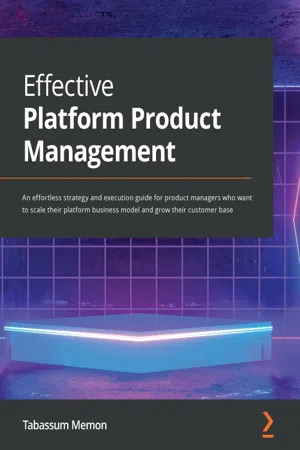
- 286 pages
- English
- ePUB (mobile friendly)
- Available on iOS & Android
Effective Platform Product Management
About this book
Turn your platform into the next big thing with expert advice to scale and implement a proven growth roadmap across multiple channelsKey Features• Gain expert insight about platform business models and how they're different to linear products• Explore the end-to-end platform life cycle, from developing a strategy to measuring the outcome• Follow real-life examples to discover the most effective growth strategies your platformBook DescriptionScaling a platform is a lot different than scaling a product. This is why product managers developing or transitioning to a platform model are often facing completely new challenges – both technical and strategic. But if you want to build the next Amazon, Netflix, Spotify, or a completely new type of platform, then you need to adopt a platform-first approach to change how you invent, develop, and market solutions. This is where Effective Product Platform Management comes in.This book addresses product management as a critical pillar of platform development. It'll help you understand the difference between traditional and modern product management for platforms and even decide whether the platform business model is the way to go for you.As you progress, you'll be able to build the right platform strategy, define the MVP, and focus on ongoing backlog prioritization for successful platforms. This book will also walk you through the practical steps and guidelines that can ease your organization's transition from linear products to platforms.By the end of this platform product management book, you'll have learned the essential aspects of product management for building successful and scalable platforms. You'll also have a clear understanding of the next steps you need to take to perfect and execute your new platform strategy – and take on the world.What you will learn• Understand the difference between the product and platform business model• Build an end-to-end platform strategy from scratch• Translate the platform strategy to a roadmap with a well-defined implementation plan• Define the MVP for faster releases and test viability in the early stages• Create an operating model and design an execution plan• Measure the success or failure of the platform and make iterations after feedbackWho this book is forIf you're a product manager, product owner, product director, or a business executive working on a platform strategy and its day-to-day execution, then this book is for you. It will also be useful for change managers and program managers tasked with transitioning from products to platforms. You won't need any prior knowledge of platform strategy or platform transitioning before you get started, since the book covers all the basics – but taking notes to reflect on your journey as you work through the practical examples in this book is recommended.
Frequently asked questions
- Essential is ideal for learners and professionals who enjoy exploring a wide range of subjects. Access the Essential Library with 800,000+ trusted titles and best-sellers across business, personal growth, and the humanities. Includes unlimited reading time and Standard Read Aloud voice.
- Complete: Perfect for advanced learners and researchers needing full, unrestricted access. Unlock 1.4M+ books across hundreds of subjects, including academic and specialized titles. The Complete Plan also includes advanced features like Premium Read Aloud and Research Assistant.
Please note we cannot support devices running on iOS 13 and Android 7 or earlier. Learn more about using the app.
Information
Section 1: Building the Right Strategy for the Platform Business Model
- Chapter 1, Fundamentals of Platform Business Models
- Chapter 2, Differences between Linear Products and Platforms
- Chapter 3, Research and Validation
- Chapter 4, Building a Platform Strategy
Chapter 1: Fundamentals of Platform Business Models
- What is a platform?
- Understanding platform business models
- Types of platforms
- Platform revenue models
- Benefits of a platform business model
- Building the right digital platform for a platform business model
What is a platform?
Understanding platform business models
- Designers: Designers can reach out to consumers worldwide without spending a lot of time and effort on doing this. They can focus on creativity and design to provide more options for consumers to choose from.
- Fashion retail platform: The platform can showcase and sell the work of different creative designers. They don't have to worry about designing, manufacturing, or producing. Their job is to connect the designers to consumers. Their success depends on how well they can scale and how many designers and consumers they can connect. The more consumers they can connect to the designers, the more revenue they generate for themselves and for the designers.
- Consumers: Consumers get access to designs from multiple designers across the globe. They can search, explore, compare, and choose between different options within a single uninterrupted User Experience (UX). Getting access to a variety of options in a single uninterrupted UX is not possible in the linear business world.
Characteristics of a platform business model
- Multidimensional
- Network effect
- Plug-and-play mechanism
Multidimensional

Networ...
Table of contents
- Effective Platform Product Management
- Contributors
- Preface
- Section 1: Building the Right Strategy for the Platform Business Model
- Chapter 1: Fundamentals of Platform Business Models
- Chapter 2: Differences between Linear Products and Platforms
- Chapter 3: Research and Validation
- Chapter 4: Building a Platform Strategy
- Section 2: Building the Platform
- Chapter 5: Defining the MVP and Creating a Platform Roadmap
- Chapter 6: Launching the Platform
- Chapter 7: Creating a Platform Operating Model
- Section 3: Measuring the Performance of the Platform
- Chapter 8: Metrics to Measure the Platform Outcome
- Chapter 9:Ongoing Backlog Prioritization
- Chapter 10: Moving from Linear Products to Platforms
- Other Books You May Enjoy